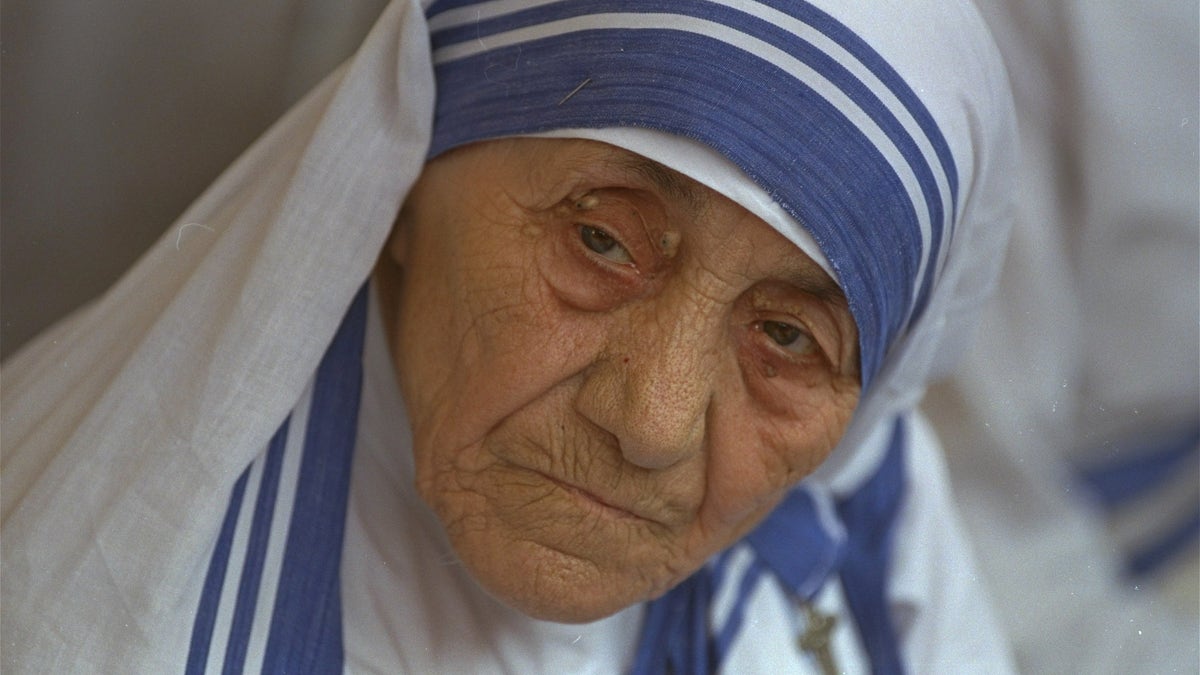
FILE - In this Aug. 25, 1993 file photo Mother Teresa, head of Missionaries of Charity, is photographed, in New Delhi, India.
Editor’s note: In 1993 author Bill Hemmer visited a Missionaries of Charity clinic run by Mother Teresa in Calcutta, India. The following essay first appeared in the Cincinnati Post newspaper on September 6, 1997, two days after her death.
Mother Teresa -- I think I'll remember her hands the most. She had these giant hands that could reach out and cover a child's face like a sacred shroud.
She used those hands to touch a little girl who had been waiting for about an hour. The girl had bone cancer.
The woman next in line carried a photo of 500 missing children in America. She was looking for a blessing, too. We all were.
A few days earlier, I was sitting in the orphanage two blocks down the street. The nun across the desk fielded every one of my nagging questions -- except one.
She refused to give me her name, saying, "That's not important." Sister was right.
Hanging on the wall behind me was a constitution which governed the Ministries of Charity. There were two basic laws written here -- "Love they neighbor" and "Help the poorest of the poor."
Simple laws from a simple boss in a very complex world of poverty.
Back at the mother house, the boss was still smiling. Flashbulbs fired through the air. A few people rolled video cameras. It was celebrity status and this 82-year-old woman, with a spine bent from age, just kept going.
She never posed, never even looked into a camera lens.
"There was too much work for pictures," she seemed to be saying.
I wondered if she had an ego. So much attention. So many kind words. There's a strong argument that lists her as one of India's most popular persons -- with 900 million people, that says something.
But through the 60-plus years of service, not once did she go looking for the attention. We simply gave it to her. That fragile woman, with the plain brown sandals and the worn face of wrinkles, had established an international reputation of love through her work in the slums of Calcutta.
At last look, she was groping through the crowd, appeasing people with her blessing and working her way to the chapel. That was her sanctuary: a rectangular room built from cement blocks two stories above street level.
She would kneel and pray in the middle of the room, up against the back wall. Same place every day.
When she bowed, that tiny frame for a body almost dissolved into her overgrown white uniform.
The prayer session and daily Mass were interesting. One took place at 6 am, the other 12 hours later. Both times, the noise from the street blocked out nearly half of the spoken prayers.
I glanced at her every time one of those trucks blasted by and she kept praying.
On a steamy Sunday morning 20 volunteers and I piled into a crowded public bus and journeyed to a Missionaries of Charity clinic in the neighborhood of Howrah -- an area best known for its portrayal in the movie "City of Joy."
On the cluttered streets of Calcutta this eight-mile trip took nearly 90 minutes. Here rush hour is every hour.
Sundays are wash days at the Howrah clinic. If you're a street kid and you need a bath, the door swings wide open. For soap, shampoo, food and medical attention, this is the place.
In one area of the courtyard inside the center, a pack of four-year-olds waited and watched a crying friend undergo treatment. Like so many of the homeless, this child had ringworm, fungus and every type of bacteria-infested skin disease imaginable.
His tears were streaming. His face in anguish. For two hours, workers picked away scabs and gently applied medication.
The crying never stopped, neither did the screams.
Throughout Calcutta, 11 of these centers are in full operation -- for lepers, the mentally handicapped, the elderly -- and this is just one city.
Over 100 countries worldwide now benefit from the Missionaries of Charity. About 3,700 sisters in total and one Nobel Prize for peace.
It all started here in Calcutta, a city where the pollution could melt your eyes and the poverty could melt your heart.
But lying beneath this blanket of depression there works a miracle.
Mother Teresa once stated that she "is only a pencil in the hands of Jesus."
Together they've drawn a rather promising picture of hope in the City of Joy.
